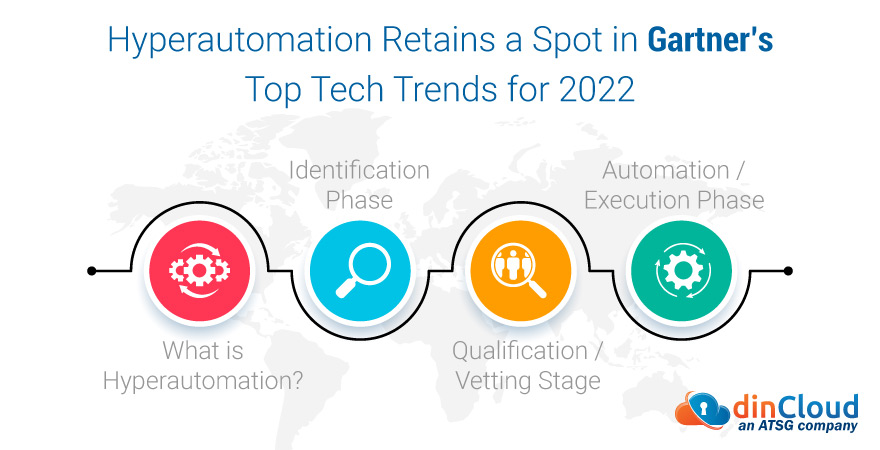Research and technology giant Gartner releases its top technology trends every year, and 2022 was no different. These top trends act as a blueprint for enterprises on how to approach digital technologies and integrate them into business processes effectively.
The technologies listed among Gartner’s top technology trends attract a lot of attention and hype from the enterprise world, and for good reason. Adopting the relevant trends results in enterprises gaining the much needed competitive edge in the market or niche.
Interestingly, Hyperautomation has retained its spot among the top twelve technology trends Gartner has highlighted for the year 2022. In this post, we will discuss why hyperautomation will help enterprises achieve better and quicker digitalization.

Related: How to Responsibly Leverage Artificial Intelligence (AI) in Cyber Security?
What is Hyperautomation?
It can be regarded as the set of all the approaches and processes, whereby an organization identifies, qualifies and then automates as many I.T as well as business processes as possible. It takes a more holistic approach towards process automation.
Here is a brief run-down of the steps involving hyperautomation, so businesses can derive real and long term value from such initiatives.
Identification Phase
There are countless individual processes that organizations define for their day to day operations. Some of these may be fully dependent upon humans, some could be mixed, while others can be fully automated with the use of the right set of tools.
So, the whole hyperautomation cycle kicks off with the identification of business processes that can be automated. This foremost step acts as a sort of “filter”, whereby only the most critical business processes are put up for hyperautomation in the initial phase.
Related: The Cyber Security Outlook by Gartner for 2022 and Beyond
Qualification / Vetting Stage
Any enterprise, no matter how resourceful, will seldom be in a position to achieve automation of all the business processes it identifies in the first phase. So, based on well defined criteria, an enterprise will vet the business processes that qualify for automation.
Automation / Execution Phase
This is a very defining element of any hyperautomation initiative in itself. How an enterprise actually approaches automation, and any incidental challenges, will play a defining role in the success of such initiatives, or otherwise.
The hyperautomation phase itself involves a lot of different technologies, tools, Robotic Process Automation (RPA) and low code platforms. All these technologies need to sync up well, and function cohesively to make it all worth the effort and resources.
Let us briefly touch upon the key tools or enablers of Hyperautomation, within the enterprise phase.
Related: How are Monitoring-as-Code & Infrastructure-as-Code Helping the Cloud
Technologies
When it comes to automating business or IT processes, technologies like Machine Learning (ML) and Artificial Intelligence (AI) have a key role to play. It is AI powered decision tools that will go on to replace the element of human involvement in such processes.
Tools for Automation
Well, it will mainly comprise of digital tools, which are capable of, and programmed to convert business processes into digital information that will serve as the “input” for the different processes that are being automated.
Robotic Process Automation (RPA)
This will involve delegating precision oriented business processes to specialized machines or robots, and the whole process will be rightly dubbed as Robotic Process Automation (RPA). RPA has wide applicability in manufacturing, testing and quality assurance (QA) processes.
Low Code Platforms
One of the key end goals of most hyperautomation initiatives will be reducing the time to market, or minimizing downtimes in themselves. This will be possible only through the use of low code platforms, which are nimble to execute, modify and troubleshoot.
The Growth Potential of Hyperautomation
According to Gartner’s estimates, the size of the hyperautomation market will surpass a respectable US $3 Billion during 2022. However, by the year 2030, the size of the global hyperautomation market could surpass US $13 Billion, a substantial increase.
Just to underscore the growth potential of hyperautomation, Gartner estimates that it will exhibit a Compound Annual Growth Rate (CAGR) of over 21%, between the years 2021 and 2031. So, enterprises need to gear up for hyperautomation really fast.
Related: The Pros and Cons of Major Cloud Service Models
Conclusion
The motivating factors, or business priorities behind hyperautomation will vary across different enterprises, depending on their industry and business models. These could include factors like quality, time to market, innovation or business model agility.
Regardless of the underlying objectives behind hyperautomation initiatives, it is vital that enterprises give serious thought to it, and incorporate it among their short, mid, and long term business plans. This in turn will immensely improve business agility and mobility.
Please contact dinCloud, an ATSG Company, for best in class cloud solutions, which can help you achieve business agility and fast track digitalization.


